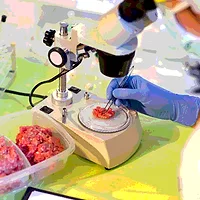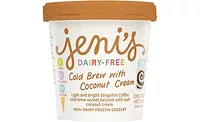Food Safety Perception Challenges: Low-Sugar Ice Cream Development
“Just a spoonful of sugar helps the medicine go down,” sang Julie Andrews in the 1964 movie Mary Poppins, and while this was an acceptable mantra in its day, it is unlikely that it would hold much favor in today’s society. Along with many other changes that have taken place in the 50 years since this movie was released, there has been a big emphasis on reducing sugar consumption in people’s diets. There is a global focus on obesity, amplified by the recently updated U.S. dietary guidelines, and strong recommendations to reduce sugars in the diet, all of which means that today’s consumers are looking for lower-sugar and lower-calorie products that are formulated to provide all the texture, flavor and indulgence of their full-sugar counterparts. Recent advances in specific ingredient technologies now make it easier for the product developer to formulate good-tasting products at lower sugar and calorie levels; however, consumer perception of the safety of some of these ingredients can in turn bring its own challenges.
Nowhere is this focus more active than in the $10 billion ice cream and frozen novelties category.
Ice cream consumers continue to demand new products that deliver all the creamy indulgence they expect from ice cream without all the sugar, calories and fat. While this represents a significant challenge for the product developer, in fact the bigger hurdle is overcoming the deeply held consumer perception that “better for you” products compromise on taste, a belief most likely driven by decades of experience and disappointment for naturally skeptical consumers. As with all foods, with ice cream, taste is king. Generally, consumers are not willing to compromise on the creamy, rich, indulgent taste experience they expect from ice cream for a few calories or grams of sugar.
Nonetheless, a significant market exists for these types of products, with most ice cream manufacturers offering lower-fat or “no sugar added” variants in their product lineups.
A particular challenge for the ice cream formulator is what to do when one removes fat and sugar from the recipe. To achieve the creamy texture characteristic of ice cream, one must replace the solids lost with other components. Failure to do so results in very icy products that do not deliver a satisfying taste experience. The numbers of suitable ingredients that have become available over the last 20 years or so have increased both the size and performance of the ingredient toolbox substantially. Recent advances in two ingredient technologies, namely high-intensity sweeteners and bulking agents, now make it possible to produce ice cream products with lower sugar and fat that deliver an indulgent, creamy taste with little or no compromise.
“No sugar added” or “NSA” ice creams started to appear on the U.S. market in the 1980s. Generally, they utilized fillers, such as polydextrose or glycerin, in place of the sugar normally found in ice cream. It is fair to say these early NSA products definitely compromised on taste delivery, but as product developers became more familiar with formulating lower-sugar recipes, and ingredient vendors began to see the potential of these kinds of products in the marketplace, the quality of these products began to improve. Indeed, by the mid-1990s, most ice cream brands carried NSA flavors as a part of their lineup.
By the mid-2000s, the ice cream category became awash with products designed to take advantage of the low-carb craze inspired by the AtkinsTM and South Beach® diets. This was subsequently followed by a next generation of better-for-you products, which promised to deliver a rich, creamy, indulgent ice cream experience at half the fat of regular ice cream. These products combined both ingredient and process technologies to create ice cream with less fat and calories but a creamy texture similar to regular ice cream.
In recent years, the increasing prevalence of weight-related health problems such as diabetes, heart disease and hypertension is leading consumers to believe they should be eating a little less overall and reducing sugar in their diet. This is expanding the market for sugar-free and reduced-sugar products. In addition, consumers continue to search out products that are devoid of ingredients with negative reputations, which all has led to a steady progression of “new and improved” high-intensity sweeteners, especially over the past 20 years or so.
High-Intensity Sweeteners
When it comes to product success in the marketplace, consumer perception is everything. In today’s social-media-dominated world, blogs and platforms such as Twitter and Facebook have become sounding boards, encouraging speedy and direct opinions from consumers. Even individual, and frequently not fact-based, concerns can quickly become viral in effect, leading to widespread perception issues around the safety of such ingredients.
For all of sugar’s negative connotations, there are few other ingredients that are more accepted on an ingredient declaration, so replacing it can be tricky when appealing to those consumers seeking “clean labels.”
Alternative sugar sources, such as agave nectar, tapioca syrup, molasses, maple syrup or honey, are all possibilities for consumers seeking shorter, simpler ingredient lists with familiar ingredient names. However, from a calorific standpoint, these are all roughly equivalent to regular sugar. The demand for lower-calorie products that deliver equivalent sweetness to regular products has led to a plethora of inventions during the last century, and a number of advances in the area of high-intensity sweeteners, including those detailed below. Artificial sweeteners are also controversial, and there have been concerns about the safety of using many of these products.
Saccharin: Saccharin was invented in 1879 at John Hopkins University and is 300–500 times sweeter than sugar. Although it has a somewhat characteristic bitter aftertaste, it became very popular during World War I due to global sugar shortages. Saccharin has a long history of safe use by humans; however, a series of experiments in the 1970s showed that consumption of large amounts caused bladder cancer in male rats. As a result, saccharin was banned in some countries (e.g., Canada) and required a warning label in the United States. In 2000, these safety decisions were reversed when scientists determined that the mechanism for bladder tumor formation in the male rats did not occur in humans. Consequently, products that contain saccharin are no longer required to carry warning labels in the United States. However, it is fair to say there is still much negative perception around this ingredient, and it does not tend to be used very widely in many food products today. It has been sold commercially under the brand name Sweet’N Low® since the 1950s.
Aspartame: Aspartame was discovered in 1965 and is marketed as Equal® and NutraSweet®. It is about 200 times sweeter than sugar, and also lacks the bitter aftertaste commonly associated with saccharin, though it does have a characteristic “metallic” taste that some people seem to be more sensitive to than others. It is actually a protein in nature, manufactured from two amino acids, phenylalanine and aspartic acid. Its use was approved by the U.S. Food and Drug Administration (FDA) in 1981 and has been shown to be safe in more than 200 studies since then. However, it has also been associated with potential health risks—some people who suffer from migraine headaches claim that aspartame triggers their headaches. In addition, people who have a disease called phenylketonuria should not consume aspartame because their bodies are unable to metabolize phenylalanine. Although it is used widely in many food and beverage products to this day, aspartame is also not very temperature stable, making it a challenge to use in products that are subject to heat treatment during their production, such as baked goods.
Sucralose: Sucralose was discovered in 1976 at King’s College, London. It was first marketed in Canada in 1991 and was granted FDA approval in 1998. It is around 600 times sweeter than sugar. In addition to its sweetness, it is very heat stable, making it an attractive choice for baked and/or heated products. Sucralose is made by chemically bonding three chlorine atoms to each molecule of sucrose. This process makes the molecule indigestible as the body does not recognize it as a carbohydrate; hence, it has no calorific value. Multiple studies have shown sucralose is safe for human consumption, though there are a few anecdotal reports of adverse reactions to it. There are some reports that claim it causes thymus damage, which could affect the immune system. This claim is based on one laboratory study in which young rats fed sucralose and low-calorie diets suffered from shrinking thymus glands. However, this is a common response for rats when they are under stress due to weight loss and is not related to sucralose consumption. Follow-up studies did not discover any evidence of immune system dysfunction; nonetheless, there is still some negative perception around it.
Stevia: Stevia is made from rebaudioside A, one of the components of the Stevia rebaudiana plant native to the tropical parts of North and South America. It is sold under various brand names, including Truvia® and PureVia® in the U.S. It can be up to 300 times sweeter than sugar, but also can have a somewhat bitter, almost licorice-type aftertaste. Stevia has the advantage of being generally perceived as natural (though that in itself is a very gray area) and is very heat stable. It has been used safely as a sweetener in Japan for several decades and is increasing in popularity recently as a sweetener of choice in many food products in the U.S., though taste issues remain a challenge to the product developer.
Monk fruit: Monk fruit is a green melon-like fruit native to Thailand and southern China. Extract from the fruit is approximately 300 times sweeter than regular sucrose. The process for extracting high-intensity sweetness components from monk fruit was patented by Procter & Gamble in 1995, and recent advances have concentrated on removing some of the bad-tasting components also associated with the fruit. It has recently been commercialized in the U.S. under the brand name Nectresse™.
Both stevia and monk fruit have the advantage of being natural sources of high-intensity sweeteners, which has potential consumer advantages. In some circumstances, such as the recently launched Nectresse product, a combination of sweeteners can minimize negative flavor impact, improve sweetener stability and enhance overall taste.
As high-intensity sweeteners provide no significant added solids to the recipe, the selection of the appropriate bulking agents to maintain acceptable ice cream texture is also key.
Bulking Agents
Another area of ingredient technology that continues to expand the toolbox of the product developer is “bulking agents.” This includes various complex carbohydrates (some of which can also have the benefit of being classified as dietary fiber) and sugar alcohols.
Sugar alcohols are modified carbohydrates that are not well absorbed in the gut, therefore contain fewer calories than regular carbohydrates. Common examples include glycerol, sorbitol, lactitol, xylitol and erythritol. However, due to the fact that they are not well absorbed, overconsumption of sugar alcohols can lead to gastrointestinal symptoms including bloating, gas and diarrhea. In addition, many of the sugar alcohols have an off taste, particularly when used at high levels. The challenge for the product developer is thus to use a combination of such ingredients, which give the functional benefits without the negative taste and/or biochemical effects. A particular nuance for the ice cream product developer is that ice cream tends to be eaten as an after-dinner treat—many people who are following sugar-restricted diets will have consumed large quantities of ingredients such as sugar alcohols throughout the day, which undoubtedly contribute to gastrointestinal issues. However, as it is ice cream that is the last food consumed, it tends to also shoulder the blame for the discomforts that subsequently follow!
Another issue in replacing common ingredients such as sugar in an ice cream recipe is related to the recent consumer trend toward, and desire for, “clean labels.” Many of the “sugar replacers” do not have familiar-sounding names and hence can create suspicion and potential rejection when they appear on an ingredient declaration. While it is true that health (in its broadest calorific sense) is on most consumers’ minds, even the most healthful ingredients and products can have image problems simply by virtue of the long list of strange-sounding names that appear within the ingredient list. This then has become another challenge for the product developer.
It is clear that there are indeed many challenges, some technical and some more related to consumer perception, in developing lower-sugar ice cream alternatives. Indeed, it is very unlikely that Mary Poppins’ optimistic view that “every task you undertake becomes a piece of cake” would be shared by many ice cream product developers today!
Jon Oldroyd, M.Sc., is currently a director of supply chain for Wells Enterprises Inc., the largest privately owned ice cream manufacturer in the U.S.
Looking for quick answers on food safety topics?
Try Ask FSM, our new smart AI search tool.
Ask FSM →








